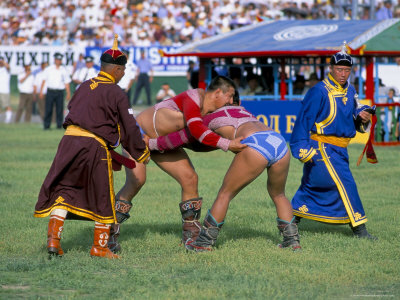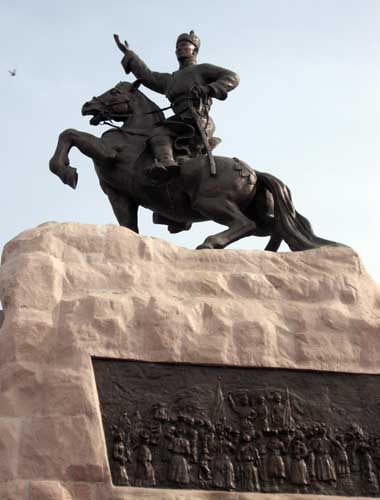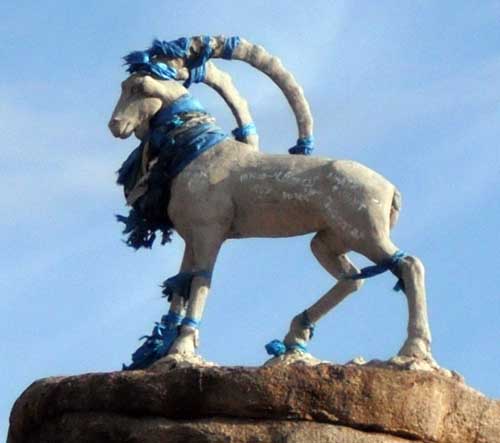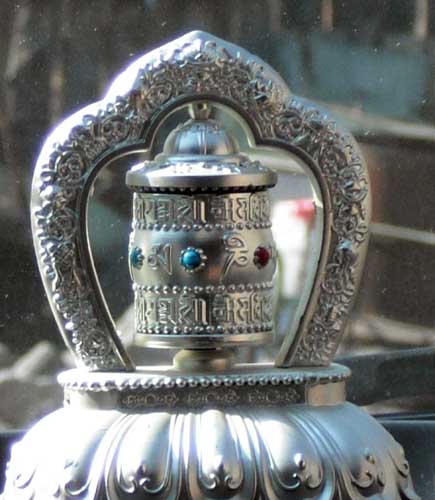|
I have way too many photos of Mongolia not to post a second letter about that experience. This, however, will be the last one.
|

|
Mongolians have a festival called "Naadam", that is held over a three day period in July. We flew out of Mongolia on the second day, but got to see some of the activities on day one. In addition to copious numbers of vendor stalls (I purchased a leather belt for ₮5000 [about $3.79]), there are three traditional sporting events: wrestling, archery, and horse racing. The origin of Naadam is a bit mirky, but it now officially commemorates the 1921 revolution when Mongolia declared itself a free country (just prior to embracing Communism). |
| The wrestling was most intriguing to me, but the cost of entering the stadium where it was held was prohibitive. In addition to a quick look through the arena door, I have watched some of it on U-tube. As with most things in Mongolia, there are very few rules. The loser is he who first touches the ground with anything other than his feet or hands. Some of the championship matches have lasted multiple hours. There are no weight classes, so the more successful participants tend towards the body shape associated with sumo wrestlers. According to our translator, a woman once won the tournament, and to prevent that from reoccurring, the costumes were modified to their present bare chested configuration. |

|

|
We spent a couple of hours at the archery meet. I imagine it was kind of like attending a major league baseball game 80 years ago. The archers (wearing their traditional costumes) mingled with the crowd when not on the firing line, and if you wished to speak to one of them, you simply walked up and did so. The men shot from 75 meters and the women from 60. The target was a row of vessels (traditionally made from woven camel skin) each about 4 inches high and 3 to 4 inches in diameter. They were stacked two high and the row was about 1.5 meters long. A successful shot knocked over more than one cup. The judges (4 to 10 of them) stood on either side of the target, and sometimes sang and danced around after a successful shot. The traditional Mongolian bow is truly a work of art, and the archers used what is called the Mongolian thumb release. I saw it in action, but haven't a clue about the dynamics of its function. The arrows have a large blunt point (probably in deference to the proximity of the target and judges) made of bone. The adornments atop the hats are indicative of success in past tournaments. It was colorful, and these people were proficient at hitting their targets. |
|
The lasts event was the horse race. Classes were based on the age of the horse. The length of the race varied with class and ranged from 15 to 30 kilometers. Up to 1,000 horses can participate. Given that lighter riders are less of a hinderance to their horse, children often serve as jockeys, and there have been many injuries. This year, the government, in the name of safety, decreed that a person had to be at least 6 years old in order to compete.
What a wild place... |

|

|
I didn't see much evidence of it in my visit, but Mongolia has and clings to a tradition of being a warrior culture. Ghinggis Khan's image adorns many things (including several denominations of paper money), and perhaps 10% of the male population (including our translator) bares his name. |
| This is what the classical Mongol warrior is thought to have looked like. If the horse appears small it is because horses in Mongolia are smaller than those in the US. I suppose that if one had only a sword, bow and arrow, and a shield for weapons, seeing this gentleman (and a thousand more like him) outside your city wall might have been a bit disconcerting. |

|

|
This warrior culture continued into the 1900's. This is one of their national heros, who also adorns their currency. Originally named Sukh (which means axe [Who would name a child Axe?]), his name was lengthened to Sukhbaater (which means axe hero) after some daring exploits as a solider. He was dismissed from the army for insubordination, but rejoined and became the general who defeated the Chinese, and shortly thereafter, the White Russians. He had a short life, dying under mysterious circumstances at the age of 30 shortly before the country became Communist. |
| This open area is named Sukhbaatar Square, and is said to the the location where Sukhbaatar proclaimed independence from the Chinese. It is next to the Government Building in the heart of Ulanbaatar, the capitol city. Mongolia claims to be the second country to adopt Communism, renaming their capitol Ulanbaatar (Meaning Red Hero--do you get the idea they have a lot of heros there?). Why they haven't renamed it since the demise of Communism is unknown. |

|

|
There is evidence of Russian influence throughout Mongolia. I saw this abandoned airstrip somewhere in southern Mongolia while flying in. Mongolia does not have an air force, but every young man spends a mandatory year in the army. |
| Maybe I'm mistaken, but I think of this as a remnant of failed government. Common across the city are places where electrical wires come out of the ground, and just end. How some street lights continue to work when next to them bare wires hang out in mud puddles, I don't know... |

|

|
These square smoke stacks are in every small town in the Mongolian countryside. I assume they are a remanent of a central heating project (or perhaps they still even function). |
| I posted a photo of this type of power poles before, but how is this for a repair of a repair of a repair? But, it is still standing, so it is hard to argue with success. |

|

|
And how about this instance where a manhole cover disintegrated, and was replace with one too large to fit in the hole. That is a road hazard, but nothing compared the potholes in their highways. It is common to be driving a major highway, and encounter a six inch drop off onto a section where the pavement is entirely missing the whole width of the road. I suspect that had I the road repair budget of all of Mongolia for an entire year, I might not be able to feed my family one meal at MacDonalds. It seems to me that selling shocks and struts in Mongolia ought to be a lucrative business. |
| Although the Communist Government tried hard to crush it, the influence of Buddhism is evident throughout Mongolia. Atop almost every hill is a pile of rocks, called an oovo (pronounced ah-wah by our translator). It is an offering to the mountain gods. It seemed reminiscent of 2 Kings 15:4 ...the high places were not removed: the people sacrificed and burnt incense still on the high places... This must have been a location having a special significance, as I counted 16 rock piles on or near this summit. |

|

|
This oovo had a single rock pile, but placed near it were the skulls from seven horses. Our translator suggested that these were a special offering (probably made after the horses were eaten). There were many oovos with paper money (small denominations) placed under some of the rocks. Our translator informed us that much of the money there was counterfeit. Perhaps the mountain gods are perceived as being not too smart... |
| Buddha is often depicted holding five colors of scarves, red, yellow, white, green, and blue. Each has a significance, but I don't remember what they were. Blue ones could be tied to almost everything across the country, a gesture that was supposed to bring luck to the one who tied them. |

|

|
I think of myself as being tolerant of religions other than my own, but I will admit that I got tired of seeing so many piece of blue cloth where I didn't expect them. |
| This is a prayer wheel. It contains the scripture, and turning one is equivalent to reading the entire volume, and offering the prayers contained inside. One of the temples we visited must have contained well over a hundred of them, and patrons made the loop, spinning each one in turn. |

|

|
This is the modern version of the prayer wheel. It sits on the dashboard of a car and is turned by a small motor attached to a solar cell. The ancient and the modern again inter-twined... Wouldn't you like a religion where you could let a photo cell do all your scripture study? |
| Lately, I have wished I had spent time studying geology, and this trip reinforce that desire. We saw many interesting rock outcroppings. Note: The white quartz vein that runs almost the entire length of this ledge, and curls up at the end. I would like to be able to explain the how and why of that photo. |

|

|
And this looks like a flow around some rocks, or else rocks crystalizing out of the flow. Features like these were common in many of the places we visited. |
| We also encountered some pictographs, not terribly unlike those that can be seen here in Arizona. |

|

|
There literally millions of sheep in Mongolia (much to Dave's dismay), and shearing them to harvest the wool takes place in the spring and early summer. |
| Most of the wool goes to China. They seem to have become the manufacturing powerhouse of the world. Mongolia does produce cashmere, and had a factory where finished goods are made from it. We visited a store in a factory, but judging from their prices, they liked their stuff a whole lot more than I did. |

|

|
These gentlemen were hunting a wolf that had killed one of their sheep the previous night. They carried a Czechoslovakian made rifle in the 7.62 NATO caliber. The rounds were said to cost about $15 each. They also had a .22 caliber rifle, with ammunition costing 75 cents each. Do you see a business opportunity here? |
| Would you buy a used car from these guys? We did... |

|

Mongolia does not manufacture cars, but imports them from everywhere (hence the reason for steering wheels on the vehicle right or left side). Toyota, Honda, Mercedes, and Hyundai are all very popular brands. I even saw one or two Fords--but only the SUV types. There were many models that I had never heard of, so it appears that American import regulations are doing their job. Many items (including cars) had English names, even though they were often misspelled or employed improper grammar. For instance, how well do you think a Grand Saloon would sell in the US? |
| This was a typical parking lot. How the cars get in or out I haven't the foggiest idea, but they all look very similar to this one. |

|

|
The swastika is a symbol that has been associate with Mongolian culture since prehistoric times, long before it was adopted by the Nazi Party in Germany. It is still widely used here, and I considered bring one home until I realized I would spend the next decade defending my possession of it... |
| Given what you know about wood, and the process that causes it to rot, would you trust this bridge? It would have been easy enough to drive around it, but we (perhaps out of sheer bravado) drove over it anyway... |

|

|
There are taxis in UB. In addition, under the right circumstances, almost any private car can be pressed into service as one. You simply hold out your hand, and people will stop. They take you where you want to go, and expect to be paid--just like a cab. We used this method to traverse UB on a couple of occasions. |
|
Dave is one of the most intense people I know, and when he is studying birds of prey, that intensity is amplified. Does he look like he can get the job done? Another bird I ought to mention is the Eurasian Coo Coo. We encountered these in many of the places we visited. They sound remarkable similar to the clock by the same name, except that they don't stop at twelve. After the first thousand, their incessant calls got a little old... |

|

|
And for those of you who have wanted to be a millionaire, I am holding a paltry 6,000,000 all in 10,000 bills.If you aren't good in math, expect to be short changed in Mongolia... |
|
The traditional dress in the countryside is the deel (pronounced dell). It is a wrap that buttons on the right shoulder and under the right arm. A sash is tied around the waist. The sleeves hang well below the hands and serve as gloves. This herdsman rode into our camp, and talked to our interpreter for a couple of hours. I have no idea about the content of their discussion, but in the countryside, foreigners are still a novelty. There is a custom in the countryside that I could hardly believe. Our interpreter not only told us about it, he demonstrated it on several occasions. If you show up in the evening at a ger of a complete stranger, he will take you in and feed you. If during the meal, you take off your hat and set it on a shelf, you have announced that you intend to spend the night. Tradition dictates that that hospitality be extended to you. So, you, the adults that live there, and their kids, will all be sleeping in the same one room ger (usually about 20 feet in diameter). What a foreign concept! There is no way is a stranger going to walk into my house and sleep at the foot of my bed... |

|

|
We (because of my reluctance) didn't try that, but the day after our night in the sheep shelter, our gear was damp and rain looked likely. Towards evening, our translator had us drive to a group of gers that appeared to belong to the same family. He talked to them a bit, and the family there agreed to moved themselves and their company (visiting from UB) out of one of their gers' and give it to us for the night. They came in, built a fire in the stove (using manure--their only fuel), and showed us how to cook in their big pot that fit an opening in the stove. I spent a short time with a boy I perceived to be about in the eighth grade, helping him read out of his English textbook. In the morning, we gave them the equivalent of about $28. That experience was almost surreal, and I wouldn't have believed it if I had not experienced it...
This gentleman came by to offer help on one of the many occasions we were stopped by vehicle problems. He couldn't help us, but we ended up giving him a couple of liters of gasoline. |
| Mongolians historically have been expert horsemen. They, however, don't use a lasso like the vaqueros in the western hemisphere. Instead, they use a loop on the end of a pole. I didn't see it in use, but the concept seems reasonable. |

|

|
I also learned that a horse cannot pull downward with his head effectively. Mongolians will run a rope between two poles at a height of about 3 meters, and tie their horses to it. Ameilia, perhaps you should remember that trick the next time you are attempting to load a recalcitrant horse into a trailer. |
| Housing in Mongolia varies greatly. In the countryside everyone lives in a ger (pronounced gear). It is of simple construction, but the thick felt covering provides excellent insulation. |

|

|
Even in the city, older people often have a ger in their yard, and usually move into it in the winter. The winters there are pretty brutal. |
| I either didn't see anything in UB that could be called a slum (or all of it is...) but this house is certainly small by western standards. |

|

|
The population of UB has exploded, and real estate is hard to come by. The result is that people build any (and every) where. How is this for a steep yard? |
| Compare that with the engineering showcase a couple of miles away, called the Blue Sky Hotel. Actually, the locals refer to it as the pregnant building. |

|

|
Some things Mongolian are straight out of the Dark Ages, and some are sheer genius. This "multi-tool" has a saw, a planer, and a drill, all run off the same 220 V motor. That seems to make a lot of sense to me--why buy three tools when one will do the job. On the down side, there isn't a safety guard anywhere. |
| There is a hugh Buddhist temple in Karakorum, the ancient capitol of Mongolia. Out side the wall, vendors have set up tables and sell souvenirs, which they claim are artifacts in spite of the fact that some still have traces of the mold material used to cast them. Capitalism is really catching on there. |

|

|
The photo doesn't do it justice, but this was the biggest, ugliest vulture head I have ever seen. There is nothing to offer scale, but it is at least 4 inches long. |
| Dave is proficient at capturing young birds, and makes it look easy. If you look closely, you can see what appears to be a hole in the tongue. It is actually the opening to the stomach. Why it is that far forward, I have no idea. |

|

|
This was our translator and his daughter. He is a likable guy with a good sense of humor. |